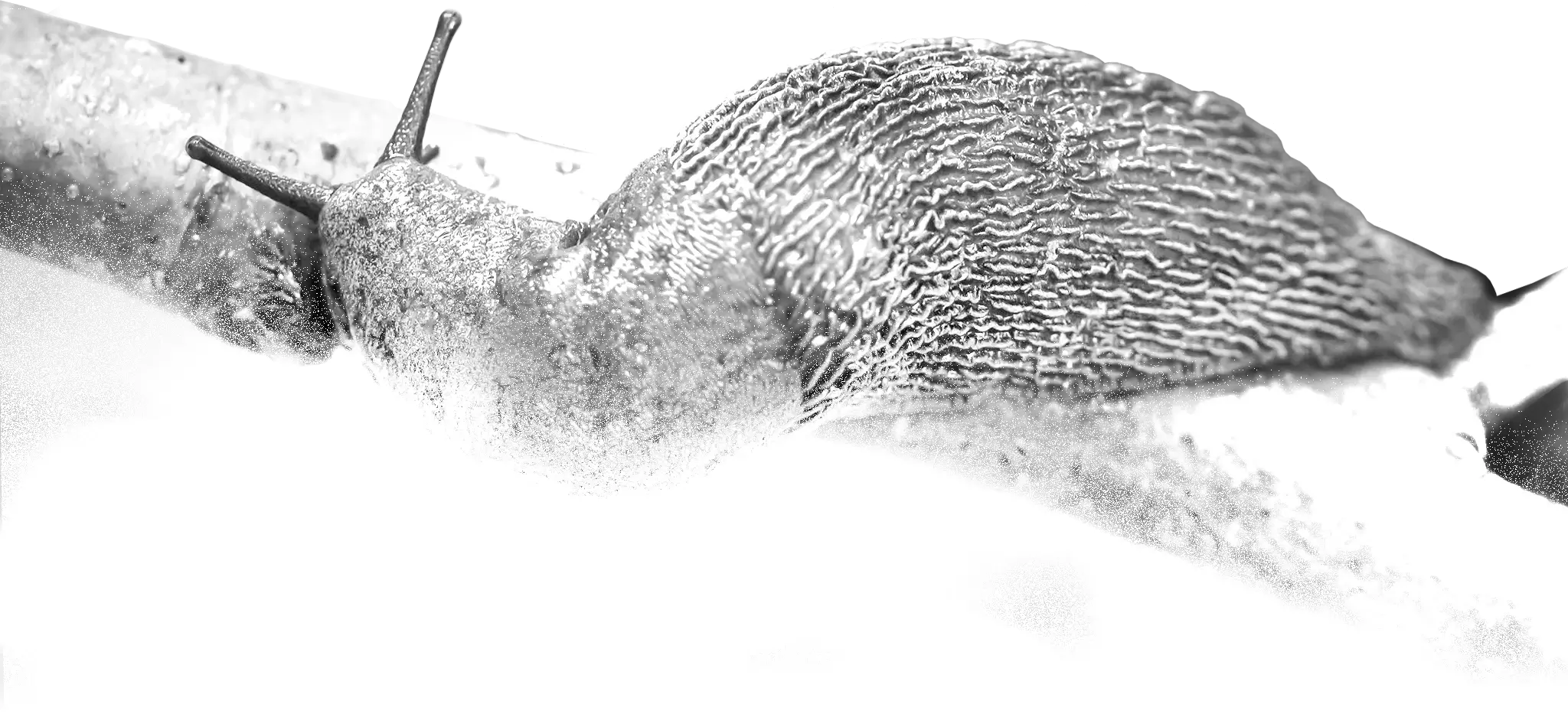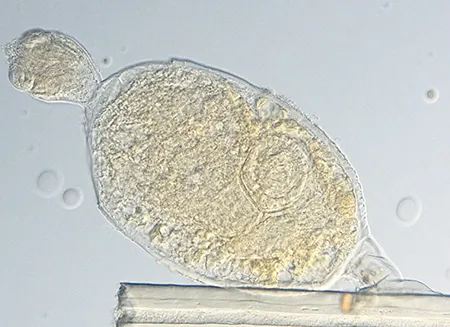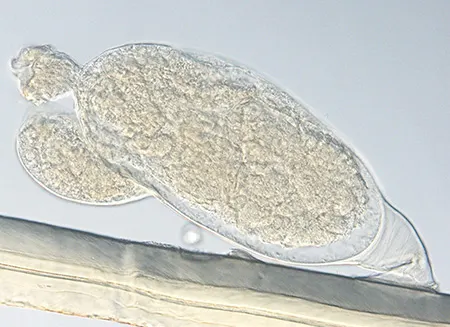
(Cycliophora)
Cycliophorans
Цикліофори
Cycliophorans are a phylum of microscopic animals without a body cavity that live as commensals on the mouthparts of lobsters. The phylum is characterized by the absence of a coelom and an extremely complex life cycle, divided into six stages. The type contains one genus, in which two species are currently described – Symbion pandora and Symbion americanus.
The best-known and best-studied stage of the cyclophore life cycle is the sessile, feeding individual, which attaches to the setae on the jaws and pedicles of lobsters. Feeding individuals are about 350 micrometers long and consist of a bell-shaped mouth funnel, a body, and a stalk with a sticky attachment disc. The inner surface of the mouth funnel is covered with cilia, while the outer surface is cilialess. The rim of the mouth funnel consists of about fifty alternating ciliated and muscular epithelial cells. The ciliated cells of the mouth funnel, by their beating, ensure the capture of food, and the muscle cells of the rim, contracting, close the mouth when the animal stops feeding.
The oral funnel narrows towards the body, and is connected to it by a narrow mobile pharynx. The pharynx may be elongated or oval, and forms the beginning of a U-shaped alimentary canal that runs from the mouth, through the pharynx to the stomach, then turns back to the head end of the animal’s body, and ends with an anus located next to the oral funnel. The stomach of cycliophorans has no true lumen, but is instead filled with a mass of cells that produce digestive enzymes. The feeding stage has no excretory system and no pronounced sense organs, and the nervous system is very simple, consisting of a mass of nerve cells around the oral funnel and a pair of nerves passing through the pharynx. No signs of a brain have been found in sedentary individuals.
The body of the cyclophore narrows towards the posterior end, and passes into a stalk, which ends in a disk for attachment. Both the stalk and this disk consist only of cuticle, and, therefore, do not contain living cells.
Lifestyle
Cycliophorans feed exclusively on the nutrient-rich environment that forms around the mouthparts of lobsters, where individuals capable of feeding form dense colonies. The number of cycliophorans depends on the age of the lobster, and ranges from a few hundred in young crustaceans to thousands in old ones. Young lobsters molt more frequently than old ones, and because the attached population of commensals dies on the shed cuticle (the “shell” of the crustacean), the number of cycliophorans on old lobsters is always greater.
Behavior
Very little data exists on the behavior of cycliophorans at all stages of their life cycle. Attached individuals have been videotaped, and these recordings have shown that the animals are capable of slowly moving the oral funnel, but retraction of the pharynx into the body has never been observed. Most free-living life stages, except for dwarf males and chordate larvae (the dispersal stage), are very poorly capable of active swimming.
Feeding
The attached stage of the life cycle is the only stage in which cycliophorans feed. When a lobster catches and eats its prey, small particles of it and nutrients enter the water around its mouth. When the cilia of the cycliophorans’ oral funnel beat, a current of water is created, directed deep into the funnel. There, the nutrient particles are captured directly by the cilia and transported through the pharynx to the stomach.
Life cycle
Cycliophorans have a very complex reproductive mechanism, with sexual reproduction alternating between one stage of the life cycle and asexual reproduction during the other two.
The attached individuals capable of feeding have no sex, but are capable of giving rise to other individuals, both sexual and asexual: male, female, and asexual larvae. Also at this stage, cycliophorans are capable of the so-called process of “self-renewal”, during which almost all living tissues are replaced by a new set of organs. This self-renewal begins with the formation of an internal bud inside the body. Inside this bud, the full set of organs characteristic of the attached individual develops, including the digestive system, nervous system, and oral funnel. When all the organs are fully developed, they begin to slowly slide forward and displace the old organs, until the new oral funnel passes through the pharynx and replaces the old one. The only parts of the old individual that remain after this process are the body shell and the attached disc. The sessile stage can repeat this process several times, and there is still no consensus among scientists as to why this is done. One explanation may be that since the attached stage has no excretory system, metabolic products continuously accumulate in the body, and self-renewal allows these metabolic products to be disposed of before they begin to poison the animal.
In addition to self-renewing internal buds, attached individuals can also give rise to an asexual non-chordoid “Pandora” larva. This larva also develops from an internal bud, and always simultaneously with the formation of a new set of organs. The fully developed non-chordoid larva exits the attached individual through the anus. It is practically incapable of swimming, but can crawl along the substrate using the ciliated surface on the ventral side of the head. When such a larva leaves the mother’s body, it slowly crawls onto the lobster’s oral setae, trying to find a suitable site for attachment using sensitive structures located on the head. Once such a site is found, the larva attaches, the larval features immediately degenerate, and a structure resembling an attached cyst is formed.
While the crawling larva is still inside the mother organism, a new, feeding individual begins to develop inside it (and becomes visible under a microscope), and this new individual contains an internal bud with bright signs of a developing oral funnel, which will be ready to self-renew immediately after the new attached individual has fully developed. When the crawling larva transforms into a cyst, the new attached individual begins to grow inside it, and in a short time the oral funnel emerges through the cyst shell, after which the new young individual begins to feed. The formation of crawling larvae occurs mainly in young colonies, usually after the molting of the host lobster, when the cyclophore population must grow rapidly to restore its numbers.
In some circumstances, asexual reproduction can be replaced by sexual reproduction. In sexual reproduction, attached individuals can produce both females and so-called promethean larvae, which give rise to males. Both, like the crawling Pandora larva, are produced by internal budding. The promethean larva can move over very short distances, and immediately after being released from the mother’s body it seeks out the nearest feeding individual with a developing female inside, after which it attaches itself to this mother near her anus. After the promethean larva has attached itself, one or two dwarf males begin to develop within it. These dwarf males are capable of active swimming, and are easily recognized by their large cuticular penises. When the female emerges from the mother’s body through the anus, the prometheus larva releases motile males, which quickly find and fertilize the female. The female looks very similar to the crawling Pandora larva, but contains a single very large oocyte (egg). It usually attaches to the mouthparts of the lobster, but not within a colony of feeding individuals. After attachment, the female begins to degenerate, forming a cyst, like the Pandora larva. Inside the cyst, a new, swimming chordoid larva begins to develop. This larva has a large number of abdominal cilia, and is a much better swimmer than any other stage of the cyclophore life cycle. Thus, it is able to swim to other lobsters, or to remain in the water while the host lobster molts. When the chordate larva attaches to the mouthparts of a lobster, it transforms into a cyst, within which an attached, feeding individual begins to develop.

(Symbion pandora)
It is microscopic aquatic animal that dwells on the mouth-parts of Norway lobsters (Nephrops norvegicus).

(Symbion americanus)
It is native to Northern America. It is a microscopic marine animal that lives on the mouth-parts of the American lobsters (Homarus americanus).

